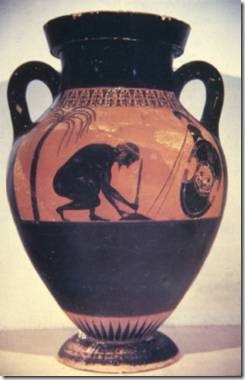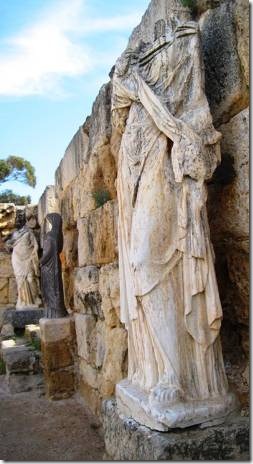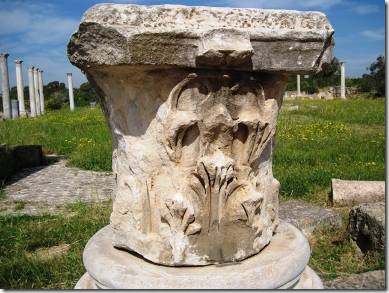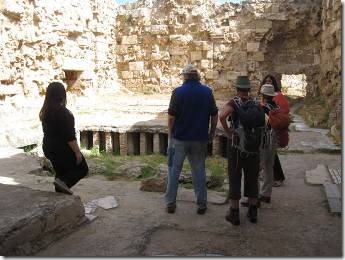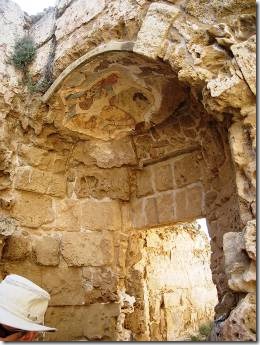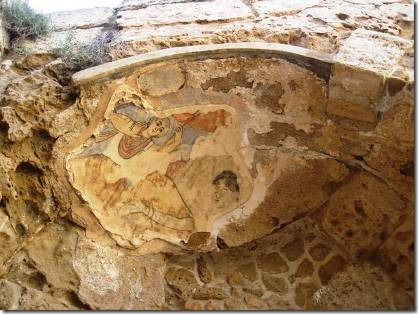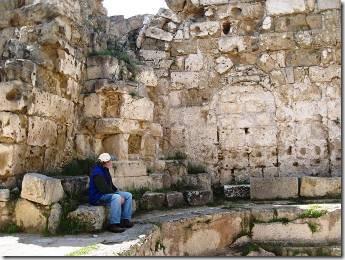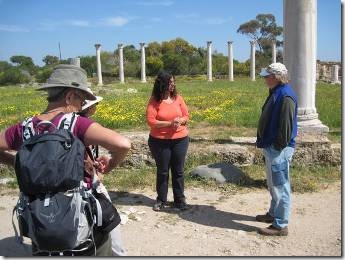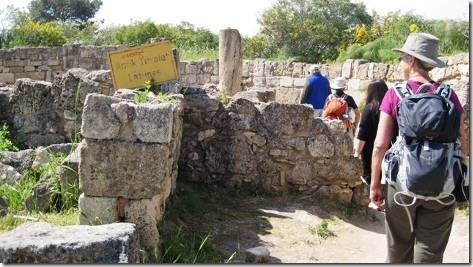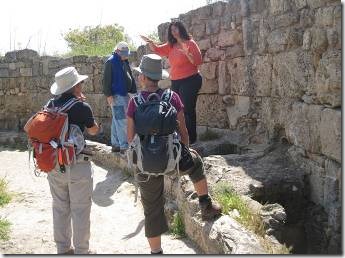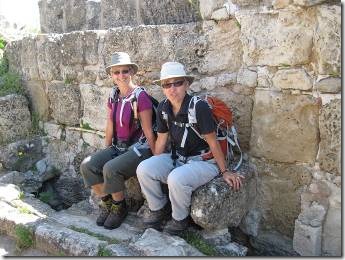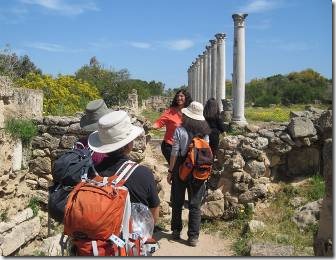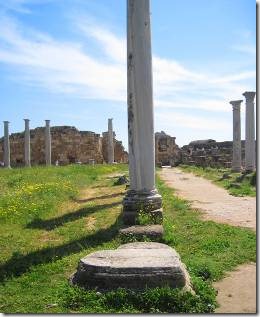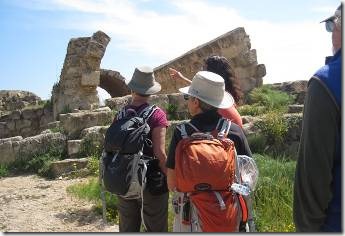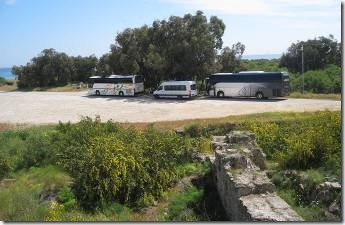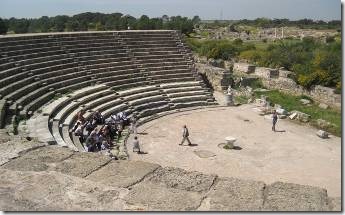Just finished putting away laundry after finishing making a banana bread with Linda after our (Linda, Charmaine and Me) 3 1/2 hour walk in Kumyali. Charmaine and Linda are of in the gym doing yoga. No rest for the weary! So now I am finishing the email about our visit to Salamis.
Ru
I really enjoyed our tour of Salamis, but we’ve done so much since then that I can’t remember many of the details. But I did take lots of photos so you can see Salamis for yourselves.
Salamis – Ancient Roman City http://www.cypnet.co.uk/ncyprus/city/famagusta/salamis/index.html
The ancient city of Salamis became the capital of Cyprus as far back as 1100 BC. The city shared the destiny of the rest of the island during the successive occupations by the various dominant powers of the Near East, viz. the Assyrians, Egyptians, Persians, and Romans. The ancient site covers an area of one square mile extending along the sea shore. There is still a large area awaiting excavation and this is forested with mimosa, pine and eucalyptus trees.
Our tour started out with the myth of the founding of Salamis……
“In Greek mythology Teucer, also Teucrus or Teucris was the son of King Telamon of Salamis and his second wife Hesione, daughter of King Laomedon of Troy. He fought alongside his half-brother, Ajax, in the Trojan War and is the legendary founder of the city Salamis on Cyprus. Teucer was the nephew of King Priam of Troy and so the cousin of Hector and Paris – all of whom he fought against in the Trojan War.
During the Trojan War, Teucer was mainly a great archer who loosed his shafts behind the giant shield of his half-brother Ajax the Great. When Hector was driving the Achaeans back toward their ships, Teucer gave the Argives some success by killing many of the charging Trojans, including Hector’s charioteer, Archeptolemus son of Iphitos.
However every time he shot an arrow at Hector, Apollo, the protector of the Trojans, would foil the shot – an ironic reference to the fact that Apollo would guide Paris’ arrow into Achilles’ heel.
In his rage at Teucer’s success, Hector picked up a huge rock, and flung it at Teucer. The rock injured Teucer, so that he should retire from the fighting for a certain period of time. He does take up a spear to fight in the war after his bow is broken by Zeus. He once again challenged Hector, and he narrowly avoided the path of Hector’s flying javelin in the ensuing battle. He was also one of the Danaans to enter the Trojan Horse.
Because of his half-brother’s suicide, Teucer was disowned by his father and emigrated to Cyprus, where he founded the city of Salamis which he named after his home state.” http://www.salamina.gr/Default.aspx?tabid=476&language=en-US
While researching the myth I found the following information….
ART 198 – HISTORY OF WORLD CERAMICS
“ In this companion piece to the last image, we see the ‘Suicide of Ajax,’ in another amphora painted by Exekias. Note the similarities between this and the last piece. Exekias skillfully balances light and dark areas, and leaves large amounts of negative space. The double honeysuckle pattern again adorns the frieze above the action. Here we see Ajax, but this time alone. Achilles has been killed in battle, and the loyal Ajax has retrieved his body from the Trojan enemy, but in an act of humiliation, he has been passed over for promotion to lead the army by his fellow Greeks. Instead, they chose Odysseus to lead them. Unable to bear the humiliation, Ajax commits suicide. While almost all other amphora painters depict the actual act of suicide in recounting this tale, Exekias characteristically shows instead the action leading up to the event. Here, Ajax has rested his shield (painted with the head of the Gorgon medusa), his helmet, and his spears, while he crouches under a tree. He is planting his sword in a mound of earth, and will soon fall upon it and die. This act of preparation is what interested Exekias, the inexorable nature of fate, rather than the actual moment of death. Note that in the Black Figure technique, bodies become silhouettes, and the only way the artist could convey detail was through Sgraffito, the technique of scratching through the slip to reveal the clay color below. This can be seen in the characteristic ‘frontal’ eye of Ajax.” http://seco.glendale.edu/~rkibler/suicideofajax.html
photo from http://seco.glendale.edu/~rkibler/suicideofajax.html I thought this was really interesting.
Ziba explaining the layout of Salamis at the start of our tour.
Where are the heads?
One answer is that they were removed in the Christian Byzantine era because they portrayed Greek and Roman gods. Another answer is they were removed and taken to the British Museum.
“The arrival of the Romans brought more peace and stability and, despite the rank of capital city passing to Paphos, Salamis developed as a major commercial centre and figured prominently in the rise of Christianity on the island. The Jewish community, feeling threatened by the rise of Christianity, revolted in 116 AD with terrible consequences which led to their slaughter or expulsion from the island. (Today there is a Jewish Chabad Lubavitch community in the South. http://www.jewishcyprus.com/)
http://www.riversideholidayvillage.com/salamis.html
I’ve been fascinated by the wild artichoke of Cyprus and here they’re carve into the column.
The complex at Salamis (basically a men’s club/spa of sorts) had rooms for everything: sweating rooms (sudatorium), hot water baths (caldarium), stoking rooms (praefurnium), swimming pools with cold water. You just had to be a rich, white male to use them.
We are in the steam bath with an underfoot heating system.
The entrance to the steam room was decorated with mosaics which we would have missed if Ziba hadn’t showed us and then told the story of the illustration.
This mural tells the story of one of Jason’s Argonauts who was “enticed by the lady of the lake to join her” as a way to explain finding all of the man’s belongings by the lake, but not him. Ziba really thought this was a recreated mural rather than the original
This might be the “cold room” where they swam but I won’t swear to it.
The gymnasium surrounded by columns.
Originally used by “naked athletes: “The word "gymnasium" comes from the Greek word gymnazein which means "to exercise naked." The name comes from the Ancient Greek term gymnós meaning "naked".” Later the area was covered over with grass and became a play space of sorts when the area was used as a school. So that’s why we have the word gymnasium meaning at times, a school or a gym.
Then we went off to the Latrines where men do business and walls have ears!
Rome for 44!
Ziba explained that the latrine was a place where men gathered to talk business and do their business. Their slaves would sit on the marble toilet stones first to “warm” them and then often help with other nastier assignments. Mostly the slaves stood outside the walls with their ears pressed to it to listen for gossip with which to blackmail their owners. So the phrase “doing your business” and “the walls have ears.”
Seating for 2.
Perfect planning… Now you see the columns………………….now you don’t, just the shadows.
The corner piece was placed and then the columns to get them in an exact row.
A system of aqueduct and cisterns supplied Salamis with water.
Cypress trees (behind the buses) were planted to drain swampy areas.
This is the theater where a reflecting wall behind the stage would “reflect” the actors’ voices back to the audience. In Greece the actors had their backs to the sea so breezes would blow the voices to the audience. Ziba, during her school days, was in the chorus of the musical Hair which was performed here. Cats and something we can’t remember were also performed here as it is still a “working theater.” Interestingly an amphitheater which is a complete circle gets its name from the world amphi which means double or both so it has “double theaters.” The amphitheater at Salamis was destroyed by an earthquake in the 6th century.
We truly had a wonderful tour and this email isn’t doing it justice…so you’ll just have to go there and ask for Ziba Kaya for your tour guide…if she hasn’t moved to the US with her boyfriend.
Since Salamis we’ve been to Kaleburnu, several days with Heidi and Kalle and some local walks in between. And our Passover Dinner with Eve! Eventually I’ll catch up
Ru
DoraMac

